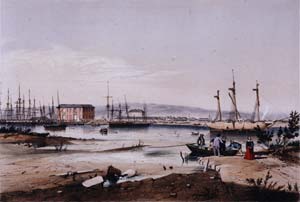
Developing trade and port histories: Port Adelaide
- Beginnings
- Further development--governance
- Wharves, bridges and slipways
- Changes in governance
- Twentieth century developments
- Flinders Ports
Beginnings

Although the first settlers and later emigrants dubbed the newly located Port of Adelaide 'Port Misery' because it was a mosquito ridden swamp, some including Colonel William Light who selected the site after much searching, saw its potential.
Colonel William Light, the Surveyor General of South Australia was directed to select the site for the main town of the new colony and one of the requirements he was directed to fulfil in that selection was: 'a commodious harbour, safe and accessible at all seasons of the year.'
His choice of the Port River was not favoured by many of the citizens including the first governor, John Hindmarsh, who considered Encounter Bay or Port Lincoln a better site. Light however had been given full powers to make the decision, and had many other factors to pull together in making that decision. The first landing place was much higher up the Port River than the current Inner Harbor: here the mangroves posed less of a problem than further downstream. However larger vessels could not approach closely, and so passengers and their goods and cargo were lightered ashore. This first landing place quickly earned the name 'Port Misery'.
Something better was needed. A landing stage and a small canal were built at this location in the hope of improving it. Two store sheds were also erected. These improvements were still inadequate if Port Adelaide was going to thrive. Hindmarsh, having been thwarted in his wish for Adelaide and its port to be sited elsewhere, opposed harbour improvements.
Following his departure, and during Governor George Gawler's tenure, proposals were made to relocate the port further downstream. At first it was proposed to site it at the junction of the river and the North Arm: the river was wider and deeper and the North Arm provided manoeuvring room. However Gawler in his instructions had been specifically warned against establishing new towns, so 'New Haven' was abandoned. There had been other mitigating circumstances as well, not least being the swamp in the area.
A compromise was reached, and the site was moved downstream to its current location, the Inner Harbor, or Gawler Reach. The South Australian Company, the organisation closely involved in the settlement and development of the colony, undertook to build the wharfage and necessary warehouse, and in addition the new road that would be needed. The new port with the road was the most important early public works in the colony - the road was raised 30 centimetres above the highest tide recorded. Mangroves were cleared where the road reached the river and wharves were built either side of the small tidal creek that now lies below lower Commercial Road. To the east of this, that is east of the present South Australian Maritime Museum lighthouse, the South Australian Company built its wharf, naming it McLaren wharf after its manager. The government built its own wharf west of the tidal creek. These works were completed 14 October 1840 and were declared open by Governor Gawler. This was the recognisable beginning of Port Adelaide.
Further development - governance
The responsibility for the young port was in the hands of the Colonial Harbourmaster, Captain Thomas Lipson. Appointed in 1836, his position was ratified with the passage of Act III, 1838. An Act for the better preservation of the Ports, Harbors...This act set out all the issues for the management of maritime matters in the colony. In 1851 a further act came into force which governed harbour safety, including lighthouses and beacons. It established a Trinity House of Port Adelaide and was based on the English Trinity House. Lipson was the first master, in addition to his other duties (See Lighthouses of South Australia for the work of Trinity House). The work expected of the new Trinity House was excessive and it was under-funded. The Port Adelaide Harbor Trust was formed in 1854 with the responsibility for excavations in the harbour. Captain Lipson retired at this time and Bloomfield Douglas assumed the position of harbourmaster. The Harbor Trust moved ahead steadily and with a newly purchased steam dredge in 1857 it removed 60,000 tons of silt from the harbour. Most of this was used for building up the commercial heart above the surrounding swamp.
Wharves, bridges and slipways
After McLaren and Queen's Wharf were built, more wharves swiftly followed. North Parade Wharf extended west from the site of the much later Birkenhead Bridge; this extended around the river as the Coal Wharf, the Port Wharf and Prince's Wharf. Levi's Wharf was constructed opposite McLaren Wharf in 1854. During the 1860s wharves continued to be added as the port continually expanded: either side of what is now the Jervois Bridge were the English and Australian Copper Company's wharf and the Corporation Wharf. The Cable Company and Colonial Sugar Refinery's wharves were opposite. Darling's Wharf was opposite Queen's Wharf and around the corner, downstream was the large Birkenhead Wharf.
On the northern side of the river Henry Fletcher built his boat yard. He acquired the slipway brought out by the South Australian Company and which had been abandoned unused on Kangaroo Island. By 1851 Fletcher's Slip was in operation. Samuel Jenkins established his shipwright business downstream from Fletcher. Other smaller yards proliferated on this stretch of the river. (See Shipbuilding)
With the harbour built along a river bridges were a necessity. The first of these was the bridge across the tidal creek between McLaren and Queen's Wharves: the creek was filled in following a series of accidents and the bridge done away with. When the South Australian Company developed the creek that ran between their McLaren Wharf and Levi Wharf opposite, into a large wet dock and basin, a bridge was needed to span the creek. This bridge was opened in 1858, replacing a temporary structure. In 1879 the South Australian Company Basin was extended necessitating another bridge. The Fisher Bridge was opened in 1880: it was an American designed 'truss' swing bridge, but easily operated by just two men. In 1883 the first bridge at the entrance to the Company Basin was replaced with a new swing bridge. This gave access to Levi Wharf and the new wharf area on the eastern bank of the river. Other bridges proliferated as the wharf areas developed.
Further Reading:
Ritter, Ron Spanning time and tide: the bridges of the Port Adelaide River, [Para Vista, S.A.] : R.C. Ritter, 1996
Items 1 - 12 of 32














